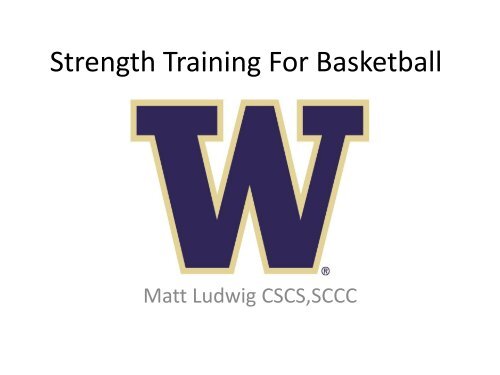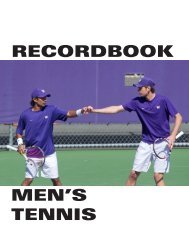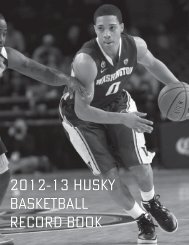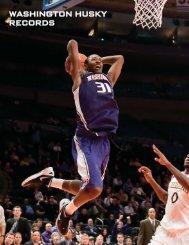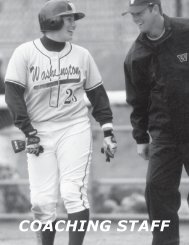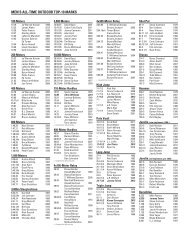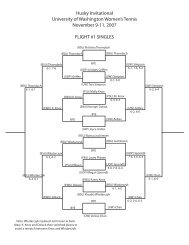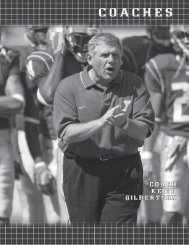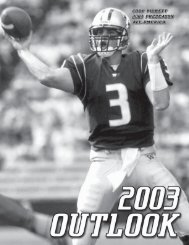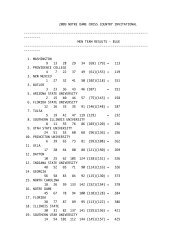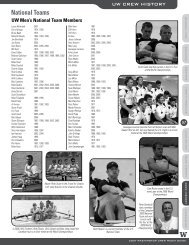Strength Training For Basketball - GoHuskies.com
Strength Training For Basketball - GoHuskies.com
Strength Training For Basketball - GoHuskies.com
Create successful ePaper yourself
Turn your PDF publications into a flip-book with our unique Google optimized e-Paper software.
Setting the framework for successHave realistic expectations:1. I want 100% of what you have left everyday2. You must be more concerned with your own development than I am.Provide the athlete a strategy for success:1. Love the game2. Be coachable3. Have a motor.Coach with consistency and intensity.1. Build a plan that addresses the demands of the program2. Establish a testing model that you can measure current and future teams by3. Avoid favoritism4. Be consistent with your discipline and your expectations5. If your excited to train them, they will be excited to train6. Show them you care, be empathetic there is more to life than just basketball.
• Two areas physical development and performance trainingbenefit a basketball program.• Develop the Individual• Develop the team
The individual• <strong>Strength</strong> training increases an individuals value to the team by:1. Building a body that is more resistant to injury.2. Developing motor skills necessary for more efficient movement.3. Improve multi directional force application for greater sprint speed, higherjump heights, more explosive directional changes.4. Improve the body’s ability to absorb these forces to further prevent injury asathletes skill level increases.5. Increasing lean muscle mass.6. Decrease rest and recovery time from individual bouts of effort and long rangebouts of effort.7. Increasing athletes total ability to <strong>com</strong>plete larger volumes of deliberate workday to day- week to week- month to month- year to year.8. Improve individual confidence in ones ability to perform, and handle stress.9. A <strong>com</strong>bination of the above should increase the individuals ability learn more<strong>com</strong>plex/advanced training methods providing more usable skills sets ingames, for longer periods of time.
• In Team <strong>Training</strong>The team1. Builds team chemistry to have athletes working together in a <strong>com</strong>monenvironment under stress working toward <strong>com</strong>mon goals.2. Teaches accountability and responsibility.3. Creates a <strong>com</strong>petitive environment where athletes can achieveimmediate tangible feedback of their strengths and weakness’s<strong>com</strong>pared to other teammates.4. Teammates can encourage one another to push through self imposedlimitations for greater sports performance.5. Allows coach an opportunity to praise individual athletes publicly,increasing an athletes drive and motivation to continue working at ahigh level of intensity.6. Provides an environment to develop leadership and help instructleaders how to lead appropriately.7. Teaches teammates how to follow leadership.
What are UW’s key points of emphasis for training abasketball player• Starts with program identification:1. Identify <strong>com</strong>mon injuries and causes: what areas pose the greatest threatto limiting practice and playing time for the athlete.2. Identify <strong>com</strong>mon performance needs of the sport: Define strength, speed,mobility, and endurance needs for the style of play.3. Identify head coach philosophy, practice model, team make up, and howyou will be evaluated on your role within athlete development.4. Identify your available resources- tools- and support systems
Common Injuries and Causes seenat UW– Common injuries :1. Ankles, Knees, Hips (Sprains- Tears- Tendonitis)2. Causes:1. Weak hamstrings and glutes2. Poor proprioception and balance3. Poor mobility in big toe- achillies- hamstrings- hip flexors- piriformisandLats4. Fatigue, Joint pain, and Poor Movement Mechanics
What do we focus on when we train?1. Fundamental Movement Skills of human movement. Building strength andstability in 3 planes of motion.2. Maximal Sprint Speed3. Sprint speed endurance (anaerobic threshold training)4. Must have a physical presence on both ends of the court, need to be STRONG5. Vertical and horizontal jumping power6. Decrease recovery time between bouts of work creating players that canrecover at the foul line or during time outs.7. Explosive lateral movement and change of directionOur program demands a very high level of work capacity to perform at a high levelfor 40 min or more, especially in the post season of play. We play a game ofcatch us if you can from tip off to the final buzzer, all season long.
Fundamental movements and testing1. Fundamental Movement Skills necessary for athlete assesment.1. Lower Body: Squat 5-3-1RM Testing year round2. Upper Body: Bench Press 10- 5-3-1RM Testing Year Round- and Chin Up Max Rep3. Total Body <strong>Strength</strong>: Power Clean 3- 1 RM Testing4. Maximal Sprint Speed: 30 yard sprint5. Sprint Speed Endurance: Figure 8 Test6. Agility: NBA Box Agility Test7. Aerobic Endurance: 1 mile run All non injured must run 5:35 or faster8. Vertical Power: Vertical Jump and Approach Jump9. Horizontal Power: Broad Jump and Single Leg Broad Jump10.Total body flexibility: Overhead Snatch Squat11. Limb Length: Height- Reach- Wing Span12. Body weight and Comp testing Guards 6-9% Post 7-11%
Husky training program1. Maximal Sprint speed:1. Max effort lower body strength- core strength- running mechanics2. Front and Back Squat- Clean Pulls- RDLs, Glute Hams and Leg Curls - Step Ups/ Lunges/ SingleLeg Squat- Calf work3. Sled pushes and pulls- foot speed drills, and sprint training.4. Weighted Core work, core endurance work, and Static core work5. <strong>For</strong>m running and sprint technique training2. Sprint speed and endurance1. Improve lactate threshold, and anaerobic fitness base with lactate threshold training and highintensity speed/ agility work.2. Sled Pushes and Pulls with short rest periods3. Multiple <strong>com</strong>binations and Supersets for lower body strength training exercises. Creating highlevels of fatigue in a periodized fashion.4. Early in Summer working on a Track- Stadium runs- 100yrd’s of lunges5. Interval Treadmill sprints at varying inclines, Man Maker Treadmill Sprints6. Our overall yearly practice model is up paced and always running.
Husky training program1. Physical Presence on Both ends of the court:1. Train to maximize total body strength and optimal body size through maximal effort work,hypertrophy training, and nutritional couseling.2. <strong>Training</strong> outside of your <strong>com</strong>fort Zone to build mental stamina: need to create challenges oftenthat cause an athlete to test courage and willingness to try. Attacking the rim vs OffensiveLinemen, Boxing Glove wrestling matches, Wrestling matches under the rim while trying to scorewith a tennis ball, jumping over a table into high jump pit, man maker runs, waterfall sledpushes, training in gymnastic room, Tough Enough Friday conditioning circuit, get creative.3. Teach them not to give up and never allowing a quitters mentality to enter the room, even if itmeans throwing out the original training plan for the day in an effort to keep the group focused.They have to want to win every day more than you.2. Vertical and horizontal jumping power1. Maximal leg strength, Back Squat- Front Squat- Deadlift- Leg Press- Glute Ham Raises2. Power <strong>Training</strong>- Power Cleans, Snatches, DB and BB Squat Jumps, Explosive Step Ups, MedicineBall Throws, Box Jumps, Depth Jumps, Bounding, Band Resisted Vertical Horizontal and LateralJumping, Jump and Landing technique training. Any and every way we can overload tripleextension we will explore in training.
Husky training program1. Decreasing rest and recovery needs1. Conditioning should be planned according to the playing season and when being in peakbasketball shape is most important.1. Offseason 1: (April – May) No organized conditioning, open gym, skill work with sportcoaches, and strength training re teaching fundamentals, and going through repairrebuildand retrain2. Offseason 2: (June) no organized team training sessions, athletes have a program 4x perweek weight training, are strongly encouraged to go on vacation, or train on their own.3. Offseason 3: (July) <strong>Strength</strong> training 4x per week, 2x per week SPARQ <strong>Training</strong> beforeworkouts 1x general conditioning post workout (treadmill sprint work) . Open gym 5-6xper week, athletes individual workouts on their own 4-6x per week.4. Offseason 4: (August) <strong>Strength</strong> training 4x per week, SPARQ training 2x per week beforelift, On court moderate intensity conditioning 1x per week, 1x per week on track- footballfield- or stadium preparing for preseason conditioning test and preseason preparationwork. Open gym 5-6x per week, athletes individual workouts on there own 4-6x per week5. Preseason: <strong>Strength</strong> <strong>Training</strong> 3x per week, on court conditioning 3x per week, skill workwith coaches 3x per week, open gym 5-6x per week. Test mile at beginning and Figure 8conditioning test at end.6. Inseason: <strong>Strength</strong> training 2-3x per week 30min sessions, Practices vary from 2-3 hours inlength in early season, during league play 1.5 -2 hours, and 1-1.5 during tournament time,always going 6x per week. NO additional conditioning outside of practice.
Husky training program1. Building explosive lateral movement and change of direction1. speed and agility work with an emphasis on mechanics2. Speed ladders, SPARQ Speed boxes3. Various ½ court agility drills emphasizing basic fundamental movements, slides, sprints to slides,sprint to back peddle, multiple direction training at top speeds, cross over to sprint.4. Skill Specific work, Close Outs, Diving on the floor, Defensive Sliding mechanics, Setting and<strong>com</strong>ing off screens….2. Very high level of GPP to perform at a high level for 40 min.1. Periodized conditioning plan for the year2. Peak conditioned shape should be in January at start of League play, and maintained throughoutremainder of season3. Offseason builds from no conditioning back into being in shape to start 8 hour per weekpractice sessions in the preseason. We play games November-March not May.4. Preseason 5 weeks of high intensity training focusing on getting in shape to start official practiceand 20 hour per week training sessions.5. Inseason: 1 st half adapting to 20 hour per week training sessions, 2 nd half in peak shape andneed to enhance basketball skill sets, offensive and defensive strategies, Neck up <strong>Training</strong> keepthem focused and motivated through the post season. Intensity and Volume management iscrucial during this time period. All conditioning done at basketball practice during inseason.
How:• To design the program I stick to several core principals that are continually evolvingas I learn more about the sport, it’s needs, and meeting the demands of thecoaching staff.• Core Principals:1. Teach what you know2. Never stop learning, Dr.Tripps3. Try new things that <strong>com</strong>pliment your strength training paradigm4. Establish a testing protocol that <strong>com</strong>pliments the physical – mental- and metabolic demands of thesport and get the head coach on board with your training methods.5. Have check points throughout the year to check progress or regression of an athlete. This will giveyou feedback on the quality of your program and allow you to catch problem areas early.6. Establish a category of strong enough, fast enough, mobile enough… so you don’t waste effort inyour training model on exercises they have already mastered. (problems with training weak link)7. Leave most of the “Sports Specific” exercises to the sport coaches. Weight room is GPP for theathlete nothing more.8. Be a fundamentals teacher, and get the basic movements mastered relative to each athlete’s ability.9. Always look for ways to catch your athletes doing things right10. Develop a good relationship with your coaches.11. Be honest and truthful all the time with feedback, testing, and evaluating your athletes andexplaining your training model.
Offseason 1: April – end of MayThis offseason’s goals were GET BIGGER, STRONGER, and IMPROVE BALANCE.1. Day 1: Olympic1. Warm Up: Jump Rope- Speed Ladder- VMO Band ¼ Squat- MB Upper Body and Torso – BackExtensions and Plate Sit Ups2. Lift: Hang Snatch- Hang Clean- Clean Pulls- Power Clean- Barbell Overhead PressingProgression- Chin Up Variations – 1 arm DB Rows- Core stability work on Foam rolls2. Day 2: Max <strong>Strength</strong>1. Warm Up: Jump Rope- Upper and Lower Body Dot Drills- Band Assisted Rack Squat Holds2. Lift: Back Squat- Bench Press- Deadlift Variation- Glute Ham Raises- Shoulder Complex-Hanging Knee Ups- Bosu Ball Sit Ups – Bridges (Planks)3. Day 3: Balance, Jump <strong>Training</strong>, Speed/Agility training, Skill work,1. Warm Up: Foam Rolling all lower body, and Back- Dynamic warm up with static stretching,Leg Swings.2. Plyo’s: Skipping forward and back, speed ski hops, ice skaters, bounding, lateral bounding,vertical and broad jump training off 1 and 2 legs/landing on 1 and 2 legs. Focus on Take offand Landing mechanics3. Sprint mechanics Band Resisted and Assisted Running, and sprint training, Moderateintensity agility work learning how to be more efficient with directional changes, very little isdone at top speeds here.4. Skill work: Tennis ball handling, tennis ball wall tosses, other drills5. Balance work in Gymnastics room on balance beam.
Offseason 1: April – end of May1. Day 4: Upper body building1. Warm up: Dynamic Warm Up- Speed Ladder- Core work2. Lift: Max effort Board Press, High Volume Chest Shoulder Tricep/ Round robin Incline Benchand Decline Push up 4-8-4, Century Set with 95-115lbs, Push Up/Incline/Decline Trisets…Round Robin Lat Pulls and Rows with high total volume, MB Pull Overs for time, HighVolume Bicep and Tricep, Band Chest Fly and Band External rotations.2. Day 5: Lower Body Building1. Warm Up: Lower Body Foam Rolling- Hurdle Drills- Ankle Bands, Band Assist Deep SquatHolds, VMO Band ¼ Squats.2. Lift: Front Squat/Leg Curl/ Slide Board Tri Set, Single Leg Squat/Plate Lunge/ Quad Pull andReach Tri Set, MB Bench Squat Jumps superset Bosu ball Squat Holds for time, ManualResisted Reverse Hypers superset Straight Leg Drops, Calf Raises.3. Additional work within the week1. Skill work with coaches and open gym2. Weekly meetings with sports nutrition3. Go to school and rest
Offseason 2: June1. Transition:1. First 2 weeks in June off from training to allow for <strong>com</strong>pensation and mental breather.2. <strong>Strength</strong> <strong>Training</strong> 4x per week, <strong>Strength</strong> exercises 3-5sets 8-12reps/ OlympicExercises 3-5 sets 3-5reps1. Day 1: After Warm Up, Clean Pulls, Hang Clean, Military Press, Chin Up, Seated Rows, Bicepwork, Band Defensive Slides, Core, Foam Rolling and Band Stretching2. Day 2: After Warm Up, Back Squat, Bench Press, Single Leg +Hamstring, Incline Bench,Shoulder Complex, Tricep Work, Hurdle Walks and Grip work, Foam Rolling and BandStretching3. Day 3: After Warm Up, Hang Snatch, Power Clean, Push Jerk, Lat Pulls, Rows, Bicep, Core,Upper and Lower Body Slide board.4. Day 4: After Warm Up, MB Box Jumps + Lying MB Toss, Incline Bench Press, Single Leg Quad +Single Leg Hamstring, Bar Shrug and Scap Depression, Pullovers and Tri Extensions, SlideBoard and Kettle Bell Swings, Single Leg Balance Work, Wrist and <strong>For</strong>earm, 4 way neck, Calf,Stretching3. Conditioning:1. General Fitness and Open Gym, Treadmill, Bike, Stadium Stair runs, athletes do any extraconditioning on their own
Offseason 3: July1. <strong>Strength</strong> <strong>Training</strong> 4x per week, <strong>Strength</strong> Exercises 3-5 sets of 5-10reps, OlympicExercises 3-5 sets of 2-4reps1. Day 1: After SPARQ training, DB ISO Military, Hang Clean, Clean Pulls (moderate), Chin Ups, BicepWork, Band Defensive Slides. Foam Roll and Stretch2. Day 2: After SPARQ training, Bench Press (Heavy), Squat (Heavy), Incline Bench, Hamstring and HipFlexor, Side Raise + Rear Fly, Tricep work, Hurdle Walks, Grip Work. Foam Roll and Stretch3. Day 3: OFF DAY4. Day 4: After warm up, Hang Snatch, Power Clean (Heavy), Lat Pulls, Rows, Curls, 4 way band hipdrills, Treadmill Sprints 1600-2000meters of total work during this phase5. Day 5: After warm up, DB Squat Jumps + Lying MB Toss, DB Bench Pressing, Squat + Hamstring work,Chin Ups, Kettle Bell Swings + Pull overs, Single Leg Balance/Stability, Calf Work.2. SPARQ and Conditioning work:1. SPARQ <strong>Training</strong> examples:1. Warm Up: Acceleration runs 30yards + hamstring stretching, High Knee Hugs and Lunge 20yards + 3 way lungestretch, Defensive Slide 15 yards + Deep Squat Stretch, 1 step Defensive Slide 10yards, Cross Over Lunge10yards2. Foot Speed Ladder Drills3. Plyo’s: High Knee Skips, (V-Hop Drills: Ice Skaters 15 yards, 2 feet side to side) Max Effort Vertical Jumps, MaxEffort Broad Jumps, Split Squat Jumps, Repeat Split Squat Jumps.4. MB Toss: Snatch, Push Jerk, Reverse Toss5. Core Work: MB Toe Touches, MB Between Knees side to side knee touches, Bridges…… Progressive overload.2. Treadmill Runs: 5x400, 800/400/400, 2x800….. All runs are 1:1 work to rest and need to be run at topspeed.
Offseason 4: August1. <strong>Strength</strong> <strong>Training</strong> 4x per week, <strong>Strength</strong> Exercises 3-5 sets of 1-8reps, OlympicExercises 3-5 sets of 1-3reps.1. Day 1: Dynamic Warm up, Speed Development, Sled Push/Pulls, Core, Push Jerk, Clean Pulls,Weighted Chin Up, Rows (heavy)+Hamstring, OH Press, Bicep Work, on court conditioning2. Day 2: Hurdles, Speed Ladder, Box Jumps, Back Squat(heavy), Bench Press (heavy), DB Incline Bench,Pull Overs, Shoulder Complex, Tricep Work3. Day 3: ON COURT <strong>Training</strong>, Dynamic warm up, MB Throws, Preseason Agility Drill Introduction,Ankle Bands, Slow Defensive Slide Suicides.4. Day 4: Dynamic Warm Up, Hurdles, Band Def Slides, Box Jumps, Hang Snatch, Power Clean, Chin Ups,Hamstring, Treadmill Runs 1600-2400 meters of total distance, Slide Board, Calf Work5. Day 5: Core work, ISO DB Bench + Seated Rows, Rev Hypers + Airex Single Leg Hops + Bosuball SingleLeg Balance, Game Day Guns, Team Run: 80yd lunge w 10 deep squat every 10yd + 60 yard sled push+ 40 yard BIG TIRE flip + 10 Sledge Hammer swings + 10 Squat Jumps + 40 yard defensive slide downand back. OUCH!! This is really hard.2. This is a very challenging time period, throughout the month of August we aredoing our fundamental testing of everything as well as increasing total volume ofwork by adding in speed and conditioning work with the strength training work.Following this training cycle is a 3 week period where athletes will take personalvacations but continue with their training in preparation for the preseason.
Preseason1. Get into basketball practice and preseason game shape.2. <strong>Strength</strong> <strong>Training</strong> 3x per week, Speed Agility and Conditioning 3x per week3. Individual Skill work 3x 40min sessions per week4. Testing 1 mile run 5:35 or faster and Figure 8 conditioning test5. Schedule:1. Day 1: On Court Conditioning, Dynamic warm up, foot speed, agility drills, Coaches basketballconditioning drills2. Day 2: Dynamic Warm up, Hurdles, Speed Ladder, 3 cone touches, Box Jumps, Power Clean + BandDef Slides, Overhead Pressing + Tuck Jumps, Single Leg exercise + Chin Ups, Rows + Hamstrings, StaticLunge with DB Curl and Press, Game Day Guns3. Day 3: On Court Conditioning, Dynamic Warm Up, Tennis Ball drills, Speed and Agility Drills, Coachesbasketball conditioning drills.4. Day 4: Foam Roll, Hurdles, 3 cone Touches, Airex Single Leg Hops, Bosu Ball Single Leg Balance,Snatches off boxes, Bench Press, DB Incline + Lying MB Toss, Shoulder Complex, EZ bar pull over +Tricep Ext + Chest Press, <strong>For</strong>earm and Grip Work5. Day 5: Dynamic Warm Up, Bounding, Speed Box + Reebok core board, Sled Drags + Sprint work, MBWall Tosses, to weight room for Back Squat + Explosive Step Ups, RDL + platform foot speed drills,Inverted Row + Hip Flexor work with band, Bicep work, Wall sits6. Rest is kept short between all activities and looking to maximize working capacity,Must make 8 hour work week feel like 20 hour.
Figure 8Conditioning TestCone 51 pointPerform 8x with 30seconds sprinting and 30secondsRest. Record the distance travelled with each setGoal is to get athletes to <strong>com</strong>plete 7 or more trips forEvery set.A very fit basketball player would have results of:7.5 - 7.25 – 7 – 7 – 7 – 6.75 – 7 – 7 = 7.06 aveOut of Shape <strong>Basketball</strong> Player would have results7 – 6.5 – 6 – 6 – 5.75 – 6.25 – 5.5 - 6.5 = 6.18 ave.75 points.5 points.25 pointsThis is a great indicator of how well or often you canRun and defend transition.StartCone 1
Inseason1. Move to 20 hours per week practice time2. Of that 20 hours I have 2 hours per week to dedicate to weight training3. Early Inseason weight training 3x per week all conditioning done in practice1. Workout 1 heavy – Workout 2 flexibility, balance, restoration- Workout 3 light and explosive4. Workouts are specifically designed for Guards- Bigs- Developmental- Redshirts1. Guards: Lower Body Power, upper body strength, core, flexibility and Mobility2. Bigs: Upper and Lower Body strength, core strength, Flexibility and Mobility3. Developmental: Technique <strong>Training</strong> and Power, core strength, Flexibility and Mobility get ready to have a great spring4. Red Shirts: 4x per week, Progressive overload training cycles, Technique <strong>Training</strong>, Hypertrophy, Fundamental Testing.5. During League Play and Tournament time weight training 2x per week1. Workout 1: Foam Roll, Dynamic Warm Up, Olympic Lift + Glute , Squat + Hamstring, Push + PullUpper Body, Shoulder Complex, Bicep and Tricep. 2-3 sets of 3-8 reps per lift. MAJOR EMPHASIS ONRange of Motion. I don’t use % during this time of year, they don’t apply.2. Workout 2: Speed Ladder, Band Defensive Slides, Bosu Ball Push Ups, Hang Snatch + 3 way HamstringStretching, DB Overhead Press + 3 way Quad Stretching, Incline Bench + 3 way Shoulder Stretching,Lat Pull + PB Hip Extensions, Lying Hip Abduction + IT Band Foam Rolling, STICK DEEP TISSUEMESSAGE, PLANTAR FACIA FOOT MESSAGE, ACHILLIES AND CALF STRETCHING, All exercises use verylight weight, speed and technique is the emphasis, and getting <strong>com</strong>pletely stretched out.
Final Thoughts.1. <strong>Basketball</strong> requires a unique blend of strength, speed, and endurance.2. Complete a program identification plan to set the foundational model for yourtraining.3. Define your fundamental testing plan.4. Build the program. Starting with the most basic movements necessary and getreally good at them. Make adjustments to the program as the athlete adapts orpresents a need; BUT STICK WITH THE KEY POINTS OF THAT PLAN TO THE END!5. Continually evaluate your program and have check points in your training cyclesthat allow you to evaluate the methods your using.6. Try new ideas and training methods one at a time throughout the year to discovermore innovative ways to get better effort out of your athletes.7. Your program must produce results that your athletes trainers and coaches cansee.8. Remember your one of hundreds of pieces to the puzzle involved with the successor failure of your program. Know your role and do it to the best of your ability.


